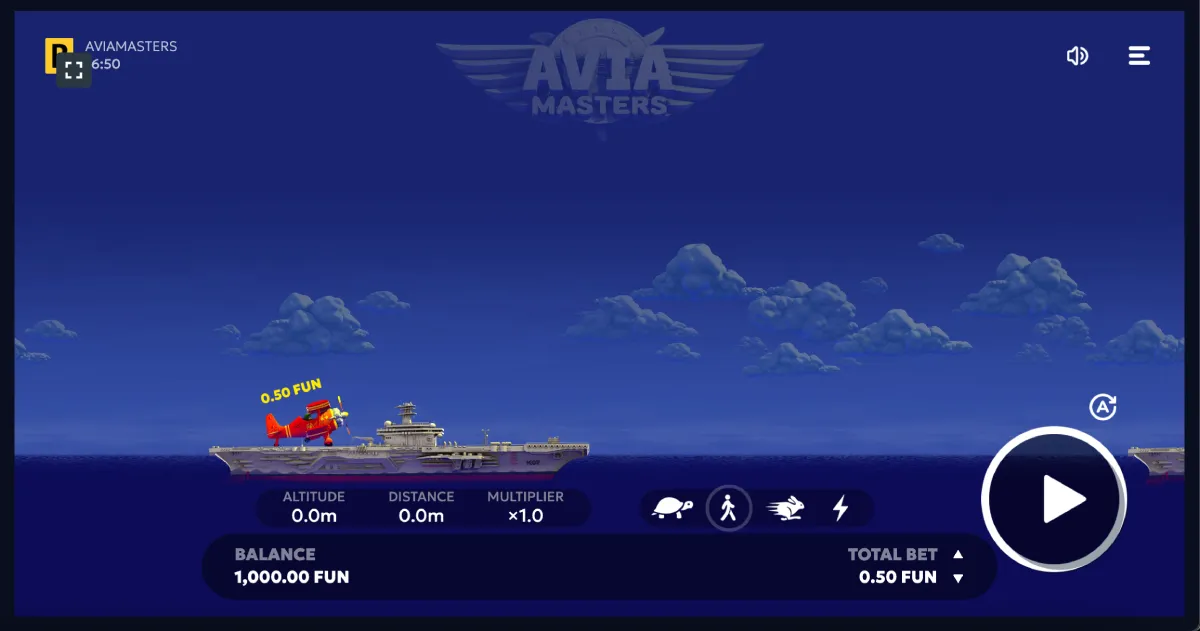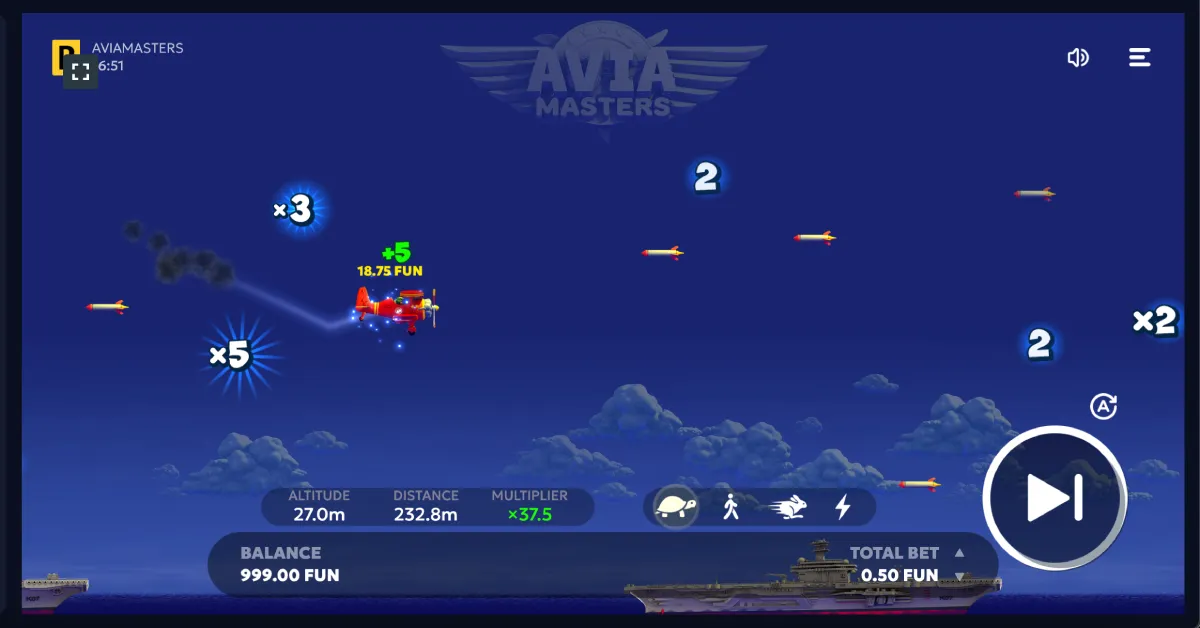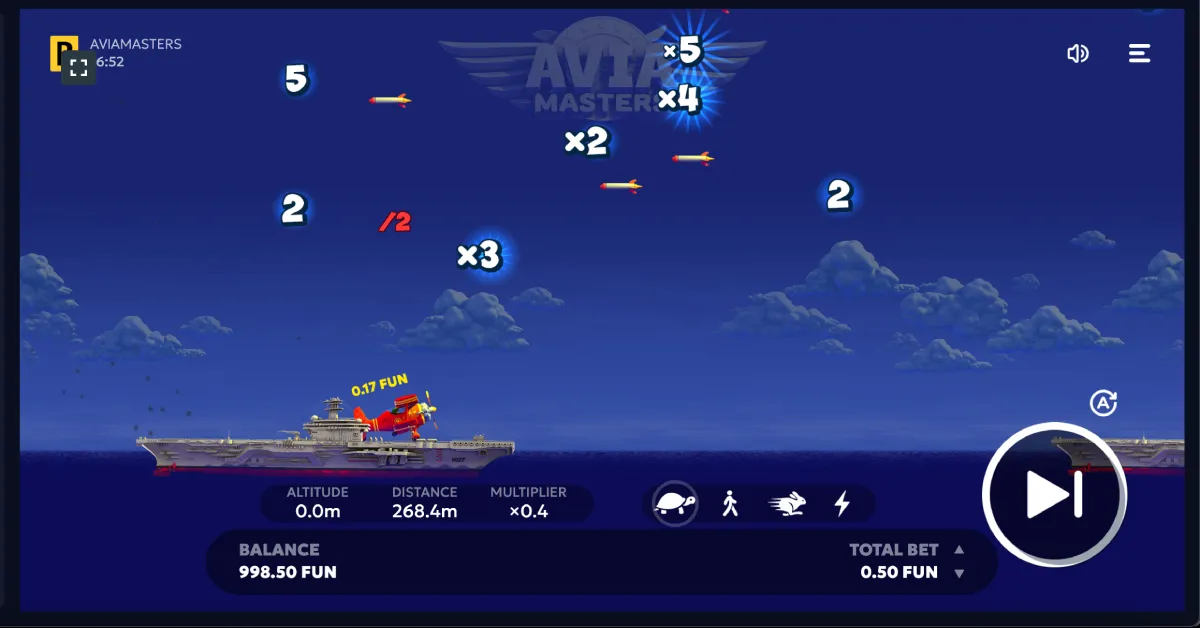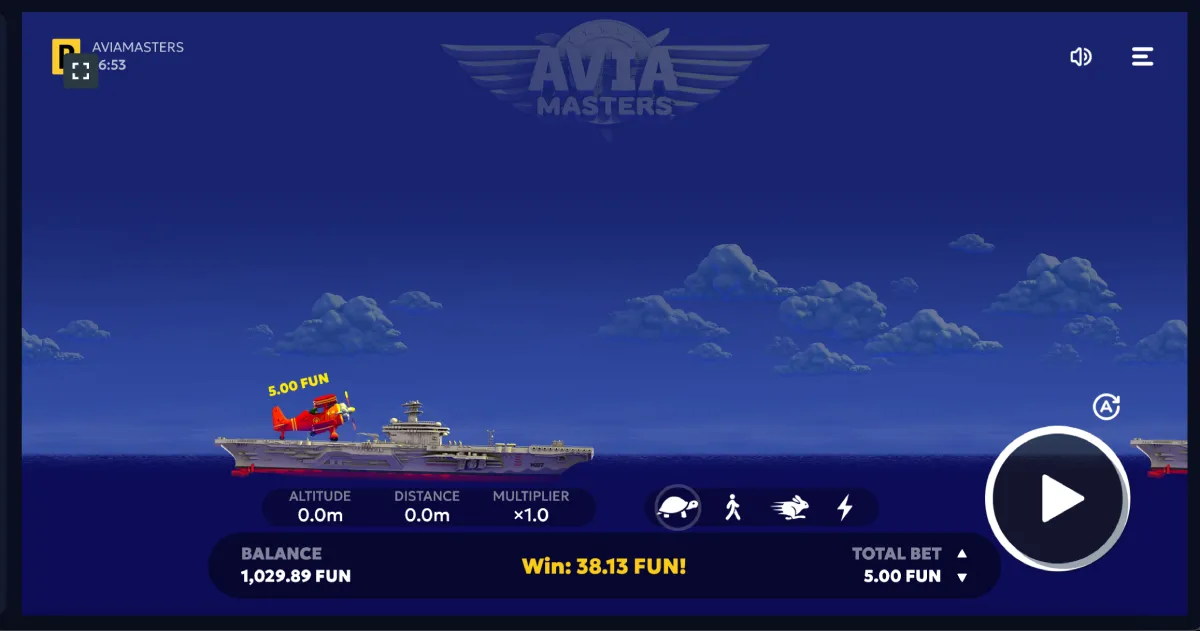Avia Masters belongs to the crash game genre, yet it brings a unique twist to gameplay and control mechanics. Unlike traditional slots where outcomes rely solely on a random number generator, Avia Masters introduces a level of player control that makes the gameplay more interactive and skill-dependent.
This guide is for those who are already familiar with the core mechanics of Avia Masters and are looking to develop a more structured approach. We’ll explore key strategies, speed control, behavior during sharp trajectory changes, and common mistakes to avoid. The material is based on real gameplay observations and analysis of long-term player behavior.

How to play Avia Masters: controlling the aircraft
Visually, Avia Masters looks like a fast-paced arcade game, but behind the scenes lies a mathematical model with specific tolerance ranges. The player controls the bet and the duration of the flight. The longer the aircraft stays in the air, the higher the multiplier – but also the greater the chance of getting hit by a missile. A payout is only granted if the plane lands successfully.
From a technical perspective, the game is about dynamically managing profit, where success depends on balancing patience and timing:
- Landing locks in your current multiplier and secures the win.
- Staying in flight boosts the multiplier but increases the risk of partial or full loss.
- A missile hit drops altitude and may end the round prematurely.
The core objective is to navigate a safe flight path with a steady multiplier increase, while knowing when to cash out. The game doesn’t reward reckless play – it favors calculated decisions. That’s why experienced players tend to use fixed exit strategies instead of chasing the “highest possible” multiplier.
Speed control: choosing the right mode
One of Avia Masters’ standout features is manual speed adjustment. There are four flight modes: turtle, walker, rabbit, and lightning. Each affects how fast the aircraft climbs, how it reacts to obstacles, and the overall pace of the round. Choosing the right mode directly impacts both the achievable multiplier and the odds of a successful landing.
Flight mode overview
| Mode | Features | When to use |
| Turtle | Slow climb, maximum control | Ideal for early stage, collecting x2–x3 |
| Walker | Balanced speed and control | A versatile choice for mid-range flying |
| Rabbit | Fast ascent, moderate risk | Good for quick gains around x5–x10 |
| Lightning | Maximum speed, high volatility | Best for short bursts or the “dash” strategy |
Practical takeaways
- Slower speeds (turtle, walker) give you more time to read the field. This is especially useful when missiles appear – you’ll have more time to react.
- Changing speed mid-flight can be a tactical move. For instance, you might start in walker mode and switch to rabbit as you approach x7–x10, if the sky looks clear.
- Lightning mode should only be used when you have a specific plan – either for quick multiplier grabs and immediate landings, or as part of a high-risk/high-reward run.
- Visual effects can distort perception: at high speeds, everything feels faster than it really is. That can throw off your landing timing. It’s worth experimenting with each speed mode to develop an internal sense of timing and rhythm.

Optimal strategies for Avia Masters
Avia Masters is a game where impulsive decisions can quickly lead to a drained bankroll. To maintain consistent results, it’s crucial to develop a clear strategy based on bet sizing, flight duration, and precise timing for landing. Below are four strategic approaches that can be tailored to different play styles.
Fixed exit point strategy
In this approach, the player predetermines the multiplier at which the flight will end – x3, x5, or any other value based on their bankroll and comfort level.
Pros:
- Stable and predictable
- Removes emotional bias
- Easy to implement
Cons:
- May miss out on higher multipliers
- Requires strict discipline
Adaptive pattern strategy
This method involves tracking multiplier behavior and adjusting decisions as the session progresses. For example, after several rounds ending at x2, a player might shift the exit point to x6–x8 if the skies remain missile-free.
Best suited for:
- Sessions that demand high concentration
- Situations where visual cues are used to determine exit points
Split risk model
The player places two simultaneous bets: one with an early exit at x2–x3, and the other aimed at a much higher target (x15+). This approach helps reduce overall volatility – if the high-risk bet fails, the early exit may still cover part of the loss.
Recommended when:
- There’s enough bankroll to sustain variable outcomes

Profit target session
Here, the player sets a clear profit goal – for example, +30% to the starting balance. Once the target is reached, the session ends. This method, often used in trading, also works well in Avia Masters by minimizing emotional overload and helping preserve profits over time.
Recommendation: avoid mixing strategies mid-session
Switching strategies mid-game is a common mistake. It’s better to choose one model and stick with it for at least 10–15 rounds. Only then should you evaluate the outcome and decide whether to adjust. This helps reduce impulsive decisions and allows for building useful stats.
How to react when missiles appear
Missiles in Avia Masters are a core threat that can drastically alter your results. Unlike traditional crash games, visual awareness plays a crucial role. Players must not only watch the multiplier climb but also read the trajectory to avoid crashes. Misjudgments at the moment of decision are a major cause of failed runs, especially when targeting mid to high multipliers.
Types of threats
- Frontal missiles: travel in a straight line and are relatively easy to predict.
- Angled missiles: intersect with the aircraft’s path at slanted angles – require altitude adjustments.
- Missile waves: unpredictable and dangerous. One missile distracts while another ends the round.
Behavioral model
- Regular altitude adjustment
Avoid flying in a straight line for too long. Gradually changing altitude lowers the chance of impact. - Reduce speed before maneuvering
At high speeds, reaction time decreases. Switching to “walker” or “turtle” modes near danger zones is a smart move. - Exit early when the situation looks unstable
If the field gets crowded or missiles become erratic, it’s often wise to land early – especially when near your planned target (e.g., x6–x8). - Track visual patterns
Missiles don’t follow a strict algorithm, but with close observation, it’s possible to notice timing patterns – how many seconds or at what multiplier threats typically appear.

Bet management: how to control your balance
One of the most common reasons players lose money in Avia Masters is the lack of a solid bet management strategy. Even with well-executed flights and successful landings, poor bankroll allocation can wipe out all progress. Unlike fixed-bet slots, here the player has full control over how much to invest in each round – which requires a structured approach.
Key principles of bet management
- Divide your bankroll by session
Before starting, set aside a specific portion of your balance for the current session and stick to it. For example, with a $100 total balance, you might allocate $30 for 10–15 rounds. This limits emotional decision-making and keeps gameplay steady. - Use a fixed percentage per round
A safe bet size is usually 5–10% of your session budget. This helps prevent full depletion after a few losses. If your session budget is $30, your bet should stay within $1.50–$3. - Avoid progressive doubling
Avia Masters doesn’t guarantee recovery after a loss, even with higher bets. “Martingale-style” systems often lead to faster losses during unlucky streaks. It’s better to keep bet sizes stable – or even reduce them after a failed round. - Set a session plan: goal and limit
Before launching, define both:
– A target profit (e.g., +20% of your starting amount);
– A loss limit (e.g., no more than –25% of your session budget).
Reaching either of these should signal the end of the session. This simple rule preserves your gains and reinforces discipline. - Track your results
Keeping notes – even brief ones like exit multiplier, speed mode, bet size, and outcome – helps you recognize patterns and adjust strategies over time. It’s a valuable tool for long-term improvement.

Common player mistakes
Even with a basic understanding of Avia Masters, players tend to repeat the same missteps, which eventually lead to negative results. Recognizing and avoiding these errors can significantly reduce unnecessary losses.
No predefined exit point
A frequent issue is continuing a flight “by feel,” hoping for a better multiplier – only to miss the right moment to land. Setting an automatic exit point (like x4) helps reduce emotion-based decisions.
Constantly switching strategies
Players often abandon their plan after just 2–3 bad rounds – changing speed modes, adjusting bet sizes, or shifting goals. This reactive approach creates chaos and disrupts the game model. Sticking with a plan for a set number of rounds provides more consistent results.
Raising bets after a loss
Trying to “win it back” with a bigger bet is a classic mistake, especially in crash-style games. A failed round followed by an aggressive bet can quickly double the loss. A rational approach favors steady – or even reduced – bet sizes after a setback.
Ignoring visual cues
Avia Masters provides a rich visual environment: flight paths, missiles, object density – all of which are part of the game’s language. Disregarding these signals is a tactical mistake. Success depends on reading the field, not blindly chasing the multiplier.
Playing too long without breaks
Fatigue is a silent threat. As sessions stretch on, attention fades and reaction time slows – making even obvious threats dangerous. The optimal approach is to pause after every 10–15 rounds, especially when playing at high speeds.
Tips for consistent play in Avia Masters
Set clear rules before starting a session
Before launching your first round, define the basics:
- Bet range;
- Maximum number of attempts;
- Target profit and acceptable drawdown limit.
Having these rules in place prevents overextension and helps maintain focus throughout the session.

Lock in partial profits
Unlike slots, where outcomes are system-generated, in Avia Masters it’s up to the player to decide when to end a round. If you’ve hit your target multiplier several times in a row, it’s often smarter to stop – even if the field appears clear. This approach helps secure your gains and avoids falling into the trap of chasing “just one more.”
Use autoplay only with a defined system
Autoplay can be convenient, but it only makes sense when key parameters are set in advance: stake size, multiplier target, and session duration. Without these in place, autoplay can quickly drain your balance due to lack of control.
Limit continuous play time
Ideally, keep individual play blocks to 20–25 minutes max. After that, take a break for at least 5 minutes. This helps preserve concentration and keeps your judgment sharp.
Review your sessions regularly
Analyzing results – even something as simple as noting which rounds were successful or not – helps refine your strategy. This is especially useful when transitioning from low to medium or high-stake games.
Understanding how to play Avia Masters begins with abandoning impulsive actions and embracing a structured mindset. From choosing the right speed mode to knowing when to land, control is everything. It’s not about chasing the biggest multiplier – it’s about managing the situation. That’s what drives consistent results.
